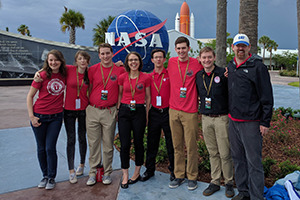 The University of Utah’s mining robot team struck gold in them Martian hills, winning the Innovation Award as well as third place overall in the 2016 NASA Robotic Mining Competition in Cape Canaveral, Florida. It is only the second time the team has competed in the annual contest.
The University of Utah’s mining robot team struck gold in them Martian hills, winning the Innovation Award as well as third place overall in the 2016 NASA Robotic Mining Competition in Cape Canaveral, Florida. It is only the second time the team has competed in the annual contest.
The Utah Robotic Mining Project — comprised of 14 members from the U’s departments of mechanical engineering, electrical and computer engineering, geology, mining engineering and computer engineering — competed May 18 to 20 with a robot that simulates scooping up Martian ice. In all, 45 schools from across the country were involved in the NASA event.
“It’s amazing,” team member and mechanical engineering senior, Teresa Petty, said about taking third place and winning the Innovation Award. “It was like the experience of a lifetime. It’s incredible just to go to NASA and get feedback from NASA engineers. So the whole team is on cloud nine right now.”
The contest involves student-designed mechanical robots that must navigate through a playfield built to simulate the surface of Mars. The robots then scoop up gravel bits and bring them to a collector bin, filling as much as it can in 10 minutes. The team’s robot, named “Master Chief” after the main character in the video game “Halo,” is nearly two feet long and wide and weighs about 150 pounds.
The team’s third-place finish is based on a number of criteria, including the robot’s performance, a presentation given by the team, the outreach effort by team members and their social media presence. The team won this year’s Innovation Award for designing a sliding scoop that can help maintain the robot’s stability.
This year’s group was sponsored by General Atomics, Northrop Grumman, Caterpillar and the Utah Mining Association. Jon Davies from the U’s electrical and computer engineering department is the team’s advisor.


